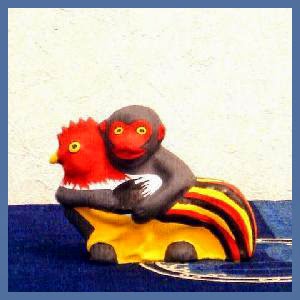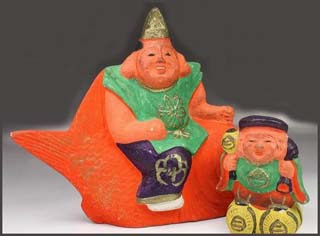:::::::::::::::::::::::::::::::::::::::::::::::::::::::::::::::::::::::::::::::::::::::::::::::::::::::::::::::::::::::::::::::::::::::::::::::::::::::::::::::::::::::::::::::::::::
| Tile Dolls 瓦人形 kawara ningyoo They are made from the same material as roof tiles and fired for finishing. The most famous are the Fushimi clay dolls 伏見人 from Kyoto. . Fushimi Clay Dolls 伏見土人形 . In Yamagata, the dolls from Tsuruoka are a bit larger, the one's from Sakata are usually smaller. They are made by pressing the clay around a doll form by hand (nukigata 抜き型) Apart from the one's in Yamagata and Fushimi, there are the following types: ................................................................................................................................................................. Imado ningyoo 今戸人形 dolls from Imado  made by 吉田義和 Yoshida Yoshikazu marushime no neko 丸〆の猫 / 丸〆猫 / manekineko 招き猫 the lucky cat from Imado Imado is located close to Asakusa in Tokyo. The clay was taken from the river Sumidagawa to produce cheap toys for the children of Edo. The last craftsman to produce these dolls was Owariya Harukichi 尾張屋春吉 who died in 1944. Now made by 白井 Imado-yaki Shrai. . . . CLICK here for Photos ! Imado yaki 今戸焼 Imado ware quote Imado Shrine 今戸神社, Imado jinja is a Japanese shrine located in Imado where north part of Tokyo Asakusa. It is one of the Shichifukujin (七福神) Shines of Asakusa, and enshrined Fukurokuju (福禄寿). The history of the shrine begins at 1063 by Yoshitomo Minamoto and Yoshiie Minamoto. It is very famous for the birth place of fortune cat (招き猫, manekineko), and last place of Soji Okita (沖田総司), the greatest samurai warrior of Shinsengumi (新撰組). Now, it is well known as good luck shrine for love and marriage. There are many good luck items for love and marriage with fortune cat. Imado Ware (Imado Yaki) Imado ware made in what is now called Imado in Taito city, was one of the most popular type of earthernware fo vessels and figures during the Edo period. The Pedestals of the guardian dogs at the Imado Shrine, carry the names of Imado potters and the date of 1752 when these figures were presented. Imado ware was said to have originated at the beginning of the Edo period, however it was not until the endo of the 18th Century that it was given the name of Imado ware. As a result, it can be presumed that Imado ware was already being produced full scale during the first half of the 18th Century. THe production of old fashioned roof tiles flourished along the banks of Sumida River. This production of Imado ware was depicted in "Edo Meisyo Zue" and in "Sumidagawa Choryu Zukan" currently being held at The British Museum. In recent years, excavations at the ruins of Edo have uncovered earthenware vessels and dolls carrying names of potters of Imado ware and also roof tiles with the impressed seal of Imado. The Great Kanto Earthquake and WWII Tokyo air raids forced almost all potters to move out of Taito city, leaving only one family, which still produces earthenware dolls of traditional figures. These include "maneki neko" know as fortune cats and "Kuchi ire kitsune" know as good life foxes. Last place of Soji Okita This shrine is also known as the last place of Soji Okita who is one of the most popular and strongest Sumurai in the Edo period. He was the team leader of 1st party of Shinsengumi. When he was suffering from tuberculosis, he was curing at this temple. However, he died because of that. It was great irony that the greatest samurai who never lost by sword fighting could never get over with his disease. Fukurokuju is the one of the enshrined god in this shrine. Fukurokuju is one of the Seven Lucky God in Japan. When you are in Asakusa, visit all Seven shrines and temple where enshrined each gods. This god brings you the happiness and long life. Enshrined God: Emperor Ojin, Izanaginomikoto, Izanaminomikoto and Fukurokuju. Pray for: Good luck for love and marriage (enmusubi). source : mustlovejapan.com  source : kyoudoningyou/imado... Hotei 布袋 . ryooen manekineko 良縁招き猫 beckoning cat for a good match from Imado shrine . . tookooshi 陶工師 Tokoshi, potters in Edo . . Hashiba 橋場 Hashiba district, "place with a bridge" and Imado . ....................................................................... 北斎 『繪本東都遊』 Katsushika Kanda Imado 今戸里 Imado district in Kanda A harbour on the Western side of 隅田川 the Sumida river. .................................................................................................................................................................. Koga ningyoo 古賀人形 dolls from Koga Nagasaki They have a tradition of more than 400 years. quote The Koga ningyo doll, along with the Fushimi ningyo doll of Kyoto and Tsutsumi ningyo doll of Sendai, is considered one of the three finest Japanese fire clay dolls. The Koga ningyo doll has ancient origins, and some believe it was made during the Genroku period in the Edo era. Several hundred such dolls existed in the old days, but today only about half remain due to breakage, weathering, and neglect from years of lack of use.  These dolls feature bold colors and the rich expressions of animal faces; however, today one can see only familiar dolls such as a Western woman with a child, a Dutch doll with a gun, and a Chinese doll holding a chicken. These dolls are plentiful and create the exotic atmosphere of Nagasaki. Today, only one workshop is continuing the tradition of simple handmade dolls source : www.at-nagasaki.jp  source : folkcraft.samurai47.com/cat Acha san 阿茶さん Portugese from Nagasaki - quote Nagasaki is an exotic and a romantic city. . . . The first Europeans to arrive in Nagasaki were the Portuguese, who brought in their colorful culture. But with the oppression of Christianity, the effect of this culture soon died out. Soon the Dutch Trade Mission in Hirato moved to Nagasaki and the Dutch culture grew to full bloom. But it was the Chinese who left the most effect on Nagasaki culture, since they were also there when the Portuguese and Dutch were there. The people of Nagasaki called them Acha-san as a sign of affiiliation. - source : hometown.infocreate.co.jp/en Recipe for Achara Zuke 阿茶羅漬け pickled turnips (from the Portugese acharl - source : www.orientalfood.com . . . CLICK here for Photos ! ....................................................................... tori daki saru 鶏抱き猿 monkey embracing a rooster niwatori saru にわとり猿 monkey and chicken  source : rakuten.co.jp/keyaki Koga dolls include a lot of animals. Some combinations of animals are not seen in other regions. Like a monkey embracing a chicken (rooster) or riding on a monkey. The monkey is an auspicious animals (saru 去る to make bad luck go away). torisaru 鶏猿 - 取り去る to go away (of bad luck) is especially auspicious. .......................................................................  - CLICK for more samples ! - . O-kage mairi お陰参り "Thanks pilgrimage" . "blessing pilgrimages," to the shrine in Ise, 伊勢参り Ise mairi ::::::::::::::::::::::::::::::::::::::::::::::::::::::::::::::::::::::::::::::::::::::::::::::::::::::::::::::::::::::::::::::::::::::::::::::::::::::::::::::::::::::::::::::::::::: . Wakayama Folk Art - 和歌山県 . Wakayama town 和歌山市 kawara ganguu 瓦玩具 clay toys from rooftile clay  source : mainichi.jp/articles 栗林八幡瓦猿 / 若宮八幡宮 clay monkeys from Hachiman Shrines They are a amulet for easy birth (安産の祈願 anzan). These dolls have provided some income for the rooftile makers of the region and have a religious background. The monkey is the messenger of various shrines. 牛は草を喰うので、瘡を草に掛けて、瓦牛で腫れ物を撫でながら「くさ喰え、くさ喰え」と唱える。  source : asahi-net.or.jp - vc3k-nrm/gang The bull is from 深草神社 Fukakusa Jinja, 津秦天満宮 Tsuwada Tenmangu and other Shrines ::::::::::::::::::::::::::::::::::::::::::::::::::::::::::::::::::::::::::::::::::::::::::::::::::::::::::::::::::::::::::::::::::::::::::::::::::::::::::::::::::::::::::: Two samples from Yamagata 山形  children with a drum  Ebisu and Daikoku, Gods of Good Luck Tsuruoka 鶴岡 and Shonai region 庄内 . . . CLICK here for more Photos ! . Folk Toys from Yamagata. . Kawara 瓦 roof tiles . - quote Kawarashi (Tiler town) 瓦師(かわらし) The area of today's 墨田区吾妻橋 Azumabashi 1-3 chōme, Sumida Ward was known as 中之郷瓦町 Nakanogō Kawara-chō (Tiler town) from the Edo period until 1930. There were many tilers' houses and a great many of the residents made a living from tiling. . source - Tokyo Metropolitan Library . :::::::::::::::::::::::::::::::::::::::::::::::::::::::::::::::::::::::::::::::::::::::::::::::::::::::::::::::::::::::::::::::::::::::::::::::::::::::::::::::::::::: . . . CLICK here for Photos ! . Reference . |
:::::::::::::::::::::::::::::::::::::::::::::::::::::::::::::::::::::::::::::::::::::::::::::::::::::::::::::::::::::::::::::::::::::::::::::::::::::::::::::::::::::::::::
. Shichi-Fukujin 七福神 Seven Gods of Good Luck -
Ebisu, Daikoku . . .
. Tohoku after the BIG earthquake March 11, 2011
[ . BACK to WORLDKIGO . TOP . ]
[ . BACK to DARUMA MUSEUM TOP . ]
- #kawaraningyo #imado #koganingyo #marushime #manekineko -
:::::::::::::::::::::::::::::::::::::::::::::::::::::::::::::::::::::::::::::::::::::::::::::::::::::::::::::::::::::::::::::::::::::::::::::::::::::::::::::::::::::::::::::::::::::


No comments:
Post a Comment